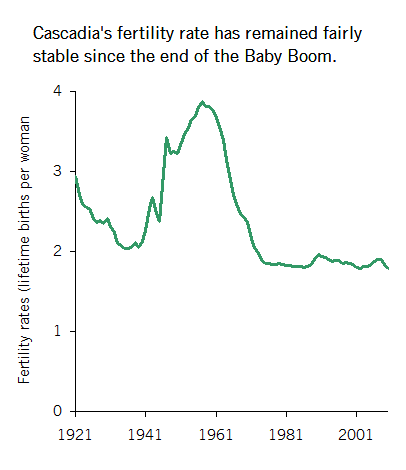Cascadia’s fertility rate—the average number of births over a woman’s lifetime, given current patterns of child-bearing—inched upwards in the mid-2000s, but declined again when the economy soured in 2008.
Yet these trends were minor, compared with the massive fertility spike of the baby boom, when Northwest fertility rates peaked at nearly 4 lifetime births per woman. Since the mid-1970s Northwest fertility rates have remained fairly stable, ranging between 1.8 and 2.0 total births over a woman’s lifetime.
A fertile population may seem like a sign of prosperity. Yet the reverse is more typically true: the world’s wealthy nations tend to have far lower rates of fertility than do struggling ones. Rapid population growth—to which high fertility contributes—can be both a cause and a symptom of economic woes. It can also strain natural ecosystems, by increasing the consumption of water, energy, and other natural resources.
Fertility rates also merit attention since they correlate strongly with the well-being of women and families. In places where women have more control over important life decisions, better access to techniques for pregnancy prevention, more economic and educational opportunities, and greater equality, women tend to delay childbearing and choose smaller families. In Sweden and the Netherlands, for example—places with robust support for families, including generous parental leave policies; where women have high levels of personal, political, and educational achievement; and where unintended pregnancies are rare—fertility rates are typically in the range of 1.7 lifetime births per woman. Although Cascadia’s overall fertility rates are close to these levels, the Northwest states still struggle with high rates of births from unintended pregnancies; between 35 and 40 percent of births in Oregon, Idaho, and Washington result from pregnancies that came earlier than the mother had intended, or that weren’t wanted at all.
 A century ago, the women of the Pacific Northwest had little control over their own lives. They were too often subject to the decisions of their fathers and husbands, and had few choices about their life paths. Lacking effective contraception, they typically started large families early in life.
A century ago, the women of the Pacific Northwest had little control over their own lives. They were too often subject to the decisions of their fathers and husbands, and had few choices about their life paths. Lacking effective contraception, they typically started large families early in life.
But those patterns have changed. Since the peak of the baby boom in the late 1950s, Cascadians have gradually shifted toward smaller families that come later in life, particularly as educational and job opportunities have opened up for women, and as medical advances and cultural shifts have given women more control over their own fertility.
Teen births in particular have experienced a massive decline—though an uneven one. The teen birth rate ticked upwards in the late 1980s, then reversed direction in the early 1990s to resume its long-term decline. British Columbia has led the way in reducing teen births. Today, teens in the province are less than one-third as likely to give birth as are teens in the Northwest states. And all across Cascadia, teen births are now at or near all-time lows.
In another sign of delayed childbearing, birthrates among BC’s forty-somethings have now overtaken the birthrate among teens. Thirty-somethings remain the province’s most fertile demographic, and now have higher birth rates than for all other ages combined.
Fertility varies considerably throughout Cascadia. Cascadia’s large cities have the smallest families: women in Vancouver, British Columbia, average about one child each. But in Canyon County, Idaho, and Yakima County, Washington, women average 2.7 births over their lifetimes.
In 1970, birthrates in British Columbia and the Northwest states were fairly evenly matched: women in both regions averaged about 2.4 lifetime births per woman. Since then, however, the regions have pulled apart, with BC women choosing smaller families than their counterparts south of the 49th parallel.  As of 2011, women in British Columbia had reduced fertility to 1.4 lifetime births, while women in the Northwest states could expect 1.9 births over their lifetimes.
As of 2011, women in British Columbia had reduced fertility to 1.4 lifetime births, while women in the Northwest states could expect 1.9 births over their lifetimes.
Cascadia has many opportunities to shift towards smaller families, later in life. More than one-third of all births (as well as virtually all abortions) in the Northwest states stem from unintended pregnancies—those that occur earlier than desired, or that were not desired at all. Children conceived intentionally are healthier, display superior verbal development in their early years, suffer less often from abuse and neglect, are less likely to enter foster care or to be charged with a crime—which makes the goal of preventing unwanted pregnancies one that Cascadians of diverse values can get behind.








